Jiawei Ma
How to Use Diffusion Priors under Sparse Views?
Dec 03, 2024Abstract:Novel view synthesis under sparse views has been a long-term important challenge in 3D reconstruction. Existing works mainly rely on introducing external semantic or depth priors to supervise the optimization of 3D representations. However, the diffusion model, as an external prior that can directly provide visual supervision, has always underperformed in sparse-view 3D reconstruction using Score Distillation Sampling (SDS) due to the low information entropy of sparse views compared to text, leading to optimization challenges caused by mode deviation. To this end, we present a thorough analysis of SDS from the mode-seeking perspective and propose Inline Prior Guided Score Matching (IPSM), which leverages visual inline priors provided by pose relationships between viewpoints to rectify the rendered image distribution and decomposes the original optimization objective of SDS, thereby offering effective diffusion visual guidance without any fine-tuning or pre-training. Furthermore, we propose the IPSM-Gaussian pipeline, which adopts 3D Gaussian Splatting as the backbone and supplements depth and geometry consistency regularization based on IPSM to further improve inline priors and rectified distribution. Experimental results on different public datasets show that our method achieves state-of-the-art reconstruction quality. The code is released at https://github.com/iCVTEAM/IPSM.
WIDIn: Wording Image for Domain-Invariant Representation in Single-Source Domain Generalization
May 28, 2024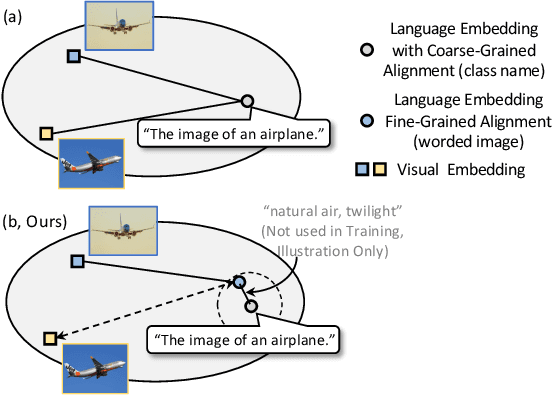
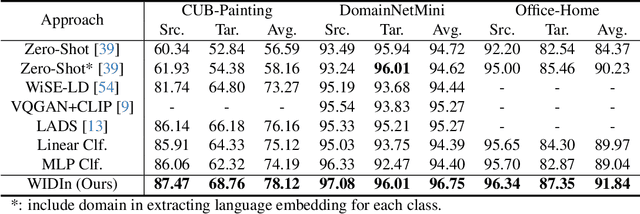

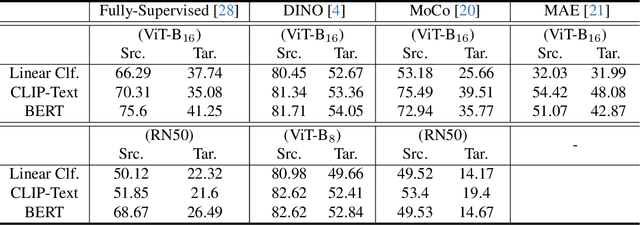
Abstract:Language has been useful in extending the vision encoder to data from diverse distributions without empirical discovery in training domains. However, as the image description is mostly at coarse-grained level and ignores visual details, the resulted embeddings are still ineffective in overcoming complexity of domains at inference time. We present a self-supervision framework WIDIn, Wording Images for Domain-Invariant representation, to disentangle discriminative visual representation, by only leveraging data in a single domain and without any test prior. Specifically, for each image, we first estimate the language embedding with fine-grained alignment, which can be consequently used to adaptively identify and then remove domain-specific counterpart from the raw visual embedding. WIDIn can be applied to both pretrained vision-language models like CLIP, and separately trained uni-modal models like MoCo and BERT. Experimental studies on three domain generalization datasets demonstrate the effectiveness of our approach.
MoDE: CLIP Data Experts via Clustering
Apr 24, 2024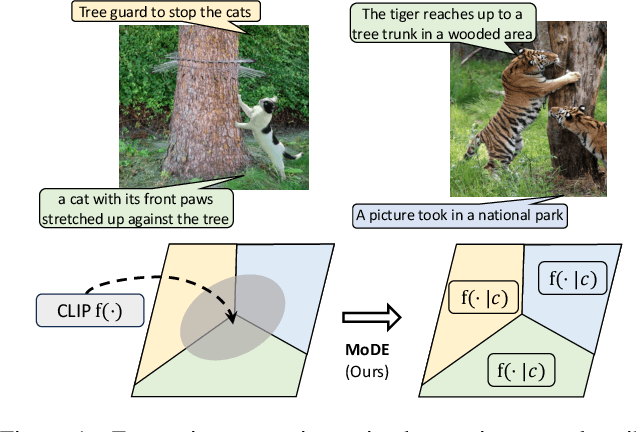
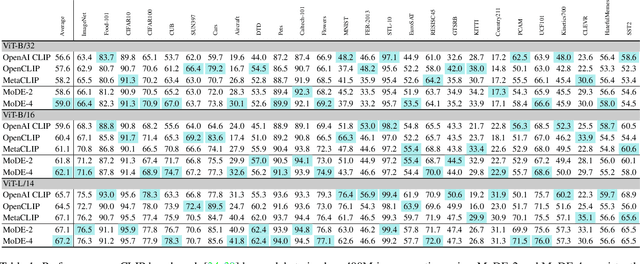

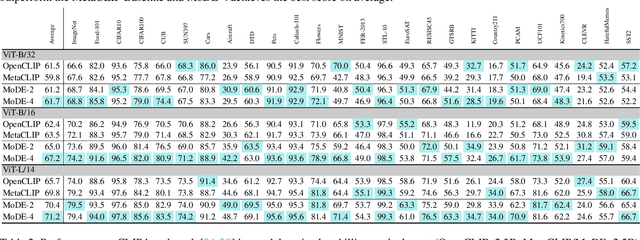
Abstract:The success of contrastive language-image pretraining (CLIP) relies on the supervision from the pairing between images and captions, which tends to be noisy in web-crawled data. We present Mixture of Data Experts (MoDE) and learn a system of CLIP data experts via clustering. Each data expert is trained on one data cluster, being less sensitive to false negative noises in other clusters. At inference time, we ensemble their outputs by applying weights determined through the correlation between task metadata and cluster conditions. To estimate the correlation precisely, the samples in one cluster should be semantically similar, but the number of data experts should still be reasonable for training and inference. As such, we consider the ontology in human language and propose to use fine-grained cluster centers to represent each data expert at a coarse-grained level. Experimental studies show that four CLIP data experts on ViT-B/16 outperform the ViT-L/14 by OpenAI CLIP and OpenCLIP on zero-shot image classification but with less ($<$35\%) training cost. Meanwhile, MoDE can train all data expert asynchronously and can flexibly include new data experts. The code is available at https://github.com/facebookresearch/MetaCLIP/tree/main/mode.
Supervised Masked Knowledge Distillation for Few-Shot Transformers
Mar 29, 2023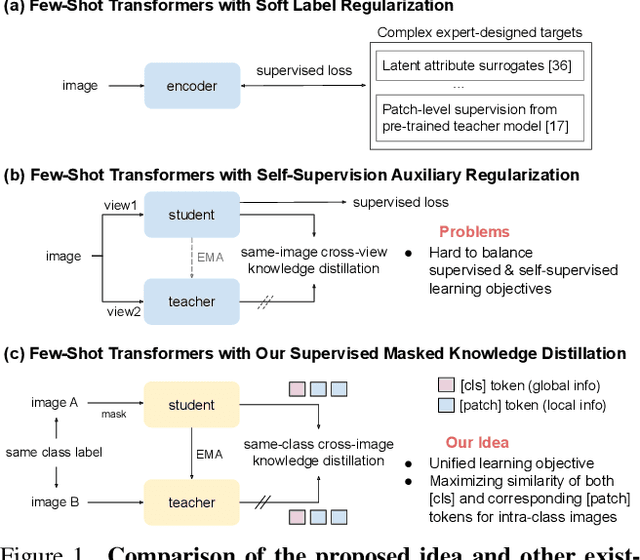
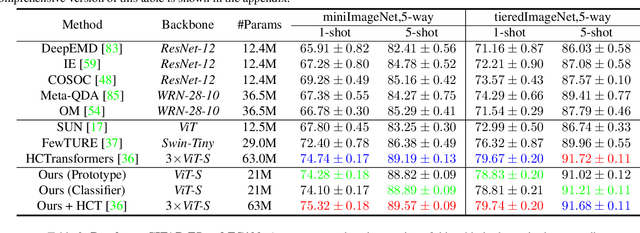
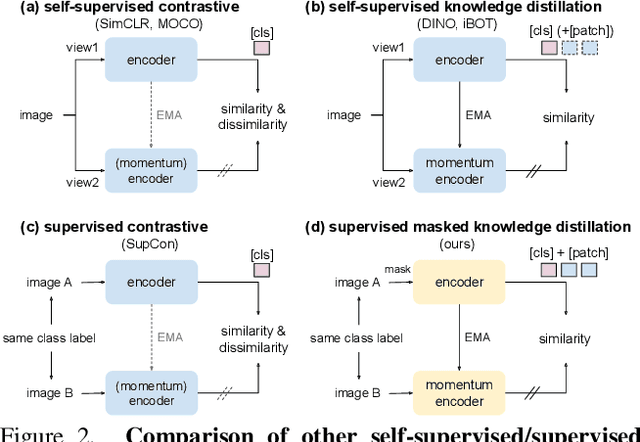

Abstract:Vision Transformers (ViTs) emerge to achieve impressive performance on many data-abundant computer vision tasks by capturing long-range dependencies among local features. However, under few-shot learning (FSL) settings on small datasets with only a few labeled data, ViT tends to overfit and suffers from severe performance degradation due to its absence of CNN-alike inductive bias. Previous works in FSL avoid such problem either through the help of self-supervised auxiliary losses, or through the dextile uses of label information under supervised settings. But the gap between self-supervised and supervised few-shot Transformers is still unfilled. Inspired by recent advances in self-supervised knowledge distillation and masked image modeling (MIM), we propose a novel Supervised Masked Knowledge Distillation model (SMKD) for few-shot Transformers which incorporates label information into self-distillation frameworks. Compared with previous self-supervised methods, we allow intra-class knowledge distillation on both class and patch tokens, and introduce the challenging task of masked patch tokens reconstruction across intra-class images. Experimental results on four few-shot classification benchmark datasets show that our method with simple design outperforms previous methods by a large margin and achieves a new start-of-the-art. Detailed ablation studies confirm the effectiveness of each component of our model. Code for this paper is available here: https://github.com/HL-hanlin/SMKD.
DiGeo: Discriminative Geometry-Aware Learning for Generalized Few-Shot Object Detection
Mar 16, 2023



Abstract:Generalized few-shot object detection aims to achieve precise detection on both base classes with abundant annotations and novel classes with limited training data. Existing approaches enhance few-shot generalization with the sacrifice of base-class performance, or maintain high precision in base-class detection with limited improvement in novel-class adaptation. In this paper, we point out the reason is insufficient Discriminative feature learning for all of the classes. As such, we propose a new training framework, DiGeo, to learn Geometry-aware features of inter-class separation and intra-class compactness. To guide the separation of feature clusters, we derive an offline simplex equiangular tight frame (ETF) classifier whose weights serve as class centers and are maximally and equally separated. To tighten the cluster for each class, we include adaptive class-specific margins into the classification loss and encourage the features close to the class centers. Experimental studies on two few-shot benchmark datasets (VOC, COCO) and one long-tail dataset (LVIS) demonstrate that, with a single model, our method can effectively improve generalization on novel classes without hurting the detection of base classes.
TempCLR: Temporal Alignment Representation with Contrastive Learning
Dec 28, 2022Abstract:Video representation learning has been successful in video-text pre-training for zero-shot transfer, where each sentence is trained to be close to the paired video clips in a common feature space. For long videos, given a paragraph of description where the sentences describe different segments of the video, by matching all sentence-clip pairs, the paragraph and the full video are aligned implicitly. However, such unit-level similarity measure may ignore the global temporal context over a long time span, which inevitably limits the generalization ability. In this paper, we propose a contrastive learning framework TempCLR to compare the full video and the paragraph explicitly. As the video/paragraph is formulated as a sequence of clips/sentences, under the constraint of their temporal order, we use dynamic time warping to compute the minimum cumulative cost over sentence-clip pairs as the sequence-level distance. To explore the temporal dynamics, we break the consistency of temporal order by shuffling the video clips or sentences according to the temporal granularity. In this way, we obtain the representations for clips/sentences, which perceive the temporal information and thus facilitate the sequence alignment. In addition to pre-training on the video and paragraph, our approach can also generalize on the matching between different video instances. We evaluate our approach on video retrieval, action step localization, and few-shot action recognition, and achieve consistent performance gain over all three tasks. Detailed ablation studies are provided to justify the approach design.
Multimodal Few-Shot Object Detection with Meta-Learning Based Cross-Modal Prompting
Apr 16, 2022

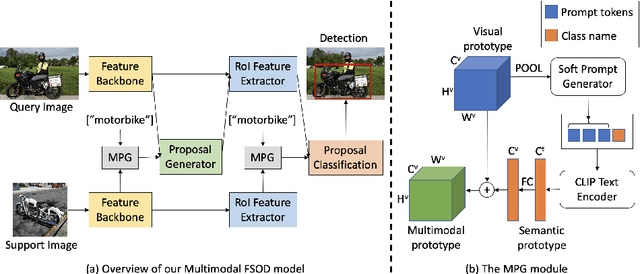

Abstract:We study multimodal few-shot object detection (FSOD) in this paper, using both few-shot visual examples and class semantic information for detection. Most of previous works focus on either few-shot or zero-shot object detection, ignoring the complementarity of visual and semantic information. We first show that meta-learning and prompt-based learning, the most commonly-used methods for few-shot learning and zero-shot transferring from pre-trained vision-language models to downstream tasks, are conceptually similar. They both reformulate the objective of downstream tasks the same as the pre-training tasks, and mostly without tuning the parameters of pre-trained models. Based on this observation, we propose to combine meta-learning with prompt-based learning for multimodal FSOD without fine-tuning, by learning transferable class-agnostic multimodal FSOD models over many-shot base classes. Specifically, to better exploit the pre-trained vision-language models, the meta-learning based cross-modal prompting is proposed to generate soft prompts and further used to extract the semantic prototype, conditioned on the few-shot visual examples. Then, the extracted semantic prototype and few-shot visual prototype are fused to generate the multimodal prototype for detection. Our models can efficiently fuse the visual and semantic information at both token-level and feature-level. We comprehensively evaluate the proposed multimodal FSOD models on multiple few-shot object detection benchmarks, achieving promising results.
Few-Shot Object Detection with Fully Cross-Transformer
Mar 28, 2022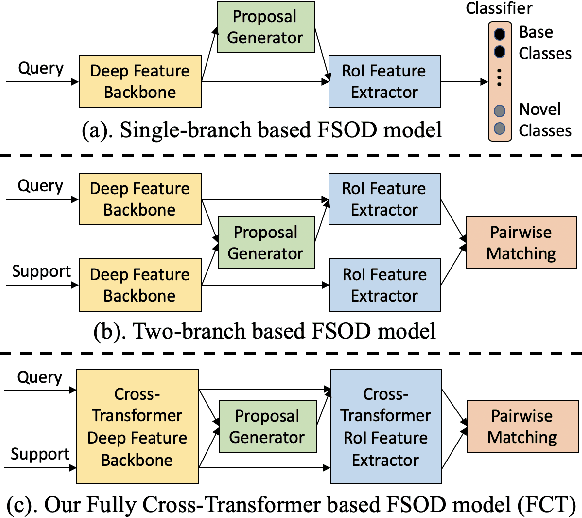
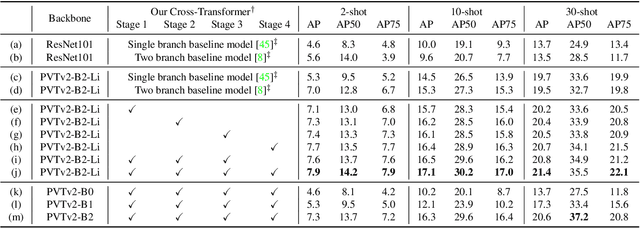
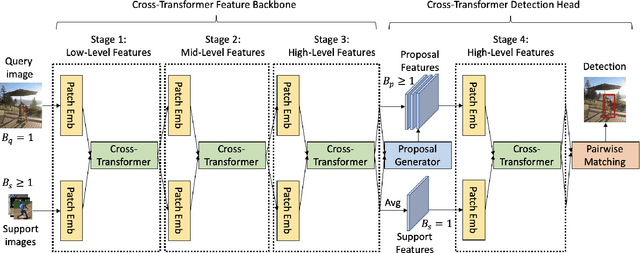
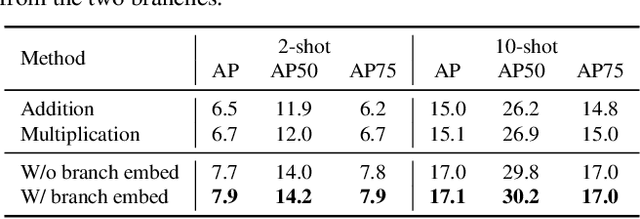
Abstract:Few-shot object detection (FSOD), with the aim to detect novel objects using very few training examples, has recently attracted great research interest in the community. Metric-learning based methods have been demonstrated to be effective for this task using a two-branch based siamese network, and calculate the similarity between image regions and few-shot examples for detection. However, in previous works, the interaction between the two branches is only restricted in the detection head, while leaving the remaining hundreds of layers for separate feature extraction. Inspired by the recent work on vision transformers and vision-language transformers, we propose a novel Fully Cross-Transformer based model (FCT) for FSOD by incorporating cross-transformer into both the feature backbone and detection head. The asymmetric-batched cross-attention is proposed to aggregate the key information from the two branches with different batch sizes. Our model can improve the few-shot similarity learning between the two branches by introducing the multi-level interactions. Comprehensive experiments on both PASCAL VOC and MSCOCO FSOD benchmarks demonstrate the effectiveness of our model.
Query Adaptive Few-Shot Object Detection with Heterogeneous Graph Convolutional Networks
Dec 17, 2021



Abstract:Few-shot object detection (FSOD) aims to detect never-seen objects using few examples. This field sees recent improvement owing to the meta-learning techniques by learning how to match between the query image and few-shot class examples, such that the learned model can generalize to few-shot novel classes. However, currently, most of the meta-learning-based methods perform pairwise matching between query image regions (usually proposals) and novel classes separately, therefore failing to take into account multiple relationships among them. In this paper, we propose a novel FSOD model using heterogeneous graph convolutional networks. Through efficient message passing among all the proposal and class nodes with three different types of edges, we could obtain context-aware proposal features and query-adaptive, multiclass-enhanced prototype representations for each class, which could help promote the pairwise matching and improve final FSOD accuracy. Extensive experimental results show that our proposed model, denoted as QA-FewDet, outperforms the current state-of-the-art approaches on the PASCAL VOC and MSCOCO FSOD benchmarks under different shots and evaluation metrics.
Partner-Assisted Learning for Few-Shot Image Classification
Sep 15, 2021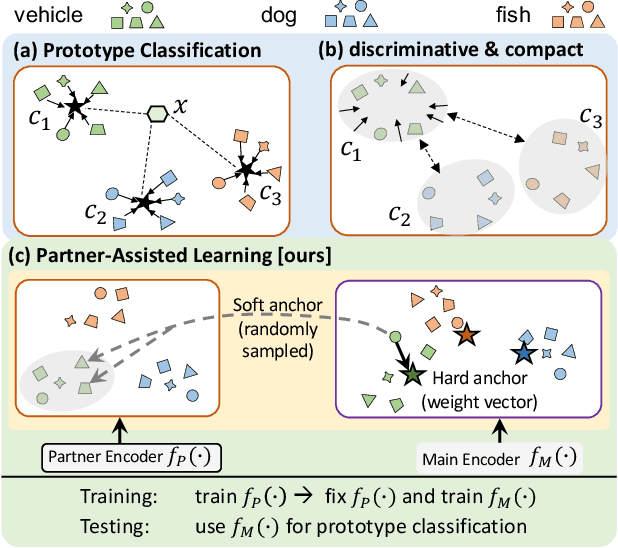
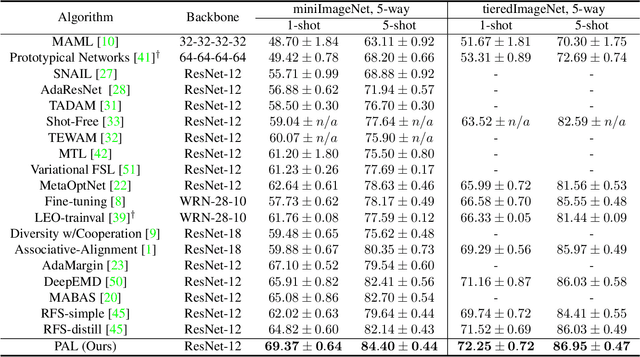

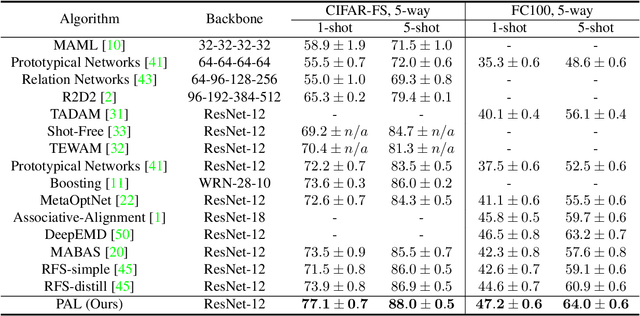
Abstract:Few-shot Learning has been studied to mimic human visual capabilities and learn effective models without the need of exhaustive human annotation. Even though the idea of meta-learning for adaptation has dominated the few-shot learning methods, how to train a feature extractor is still a challenge. In this paper, we focus on the design of training strategy to obtain an elemental representation such that the prototype of each novel class can be estimated from a few labeled samples. We propose a two-stage training scheme, Partner-Assisted Learning (PAL), which first trains a partner encoder to model pair-wise similarities and extract features serving as soft-anchors, and then trains a main encoder by aligning its outputs with soft-anchors while attempting to maximize classification performance. Two alignment constraints from logit-level and feature-level are designed individually. For each few-shot task, we perform prototype classification. Our method consistently outperforms the state-of-the-art method on four benchmarks. Detailed ablation studies of PAL are provided to justify the selection of each component involved in training.
 Add to Chrome
Add to Chrome Add to Firefox
Add to Firefox Add to Edge
Add to Edge